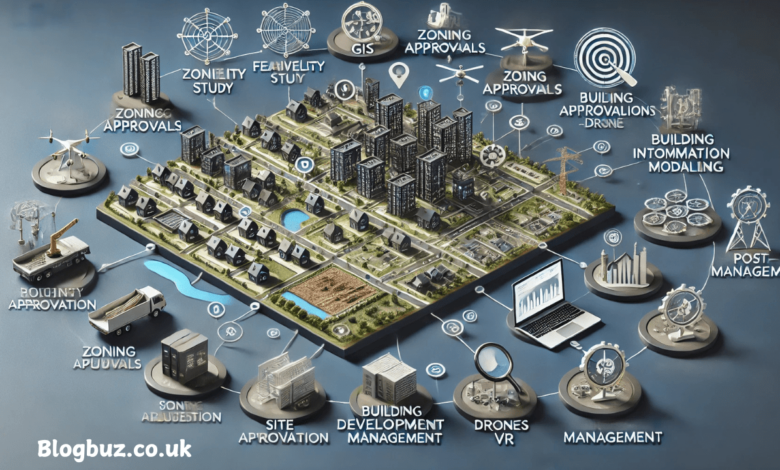The LDM Process in Real Estate: A Step-by-Step Guide

The LDM process in real estate, or Land Development Management, is crucial in ensuring successful property development. From feasibility studies to post-construction management, every stage is essential for optimizing efficiency, reducing risks, and ensuring compliance with regulatory requirements. This comprehensive guide will explore the key stages of the LDM process, its benefits, challenges, and how modern technology enhances real estate development.
What is the LDM Process in Real Estate?
The LDM process in real estate refers to a structured approach to managing land development. It includes everything from initial feasibility studies to zoning approvals, infrastructure development, construction, and final property management. A well-executed LDM process ensures that real estate projects are completed efficiently, legally compliant, and financially viable.
Key Stages of the LDM Process
Feasibility Study and Due Diligence
Before acquiring land for development, a feasibility study is conducted to assess potential risks and returns. This stage includes:
- Market Analysis: Evaluating demand, pricing trends, and potential competition.
- Legal and Title Search: Verify property ownership and ensure no disputes.
- Environmental Assessment: Checking flood zones, soil conditions, and protected habitats.
- Infrastructure Availability: Assessing access to water, electricity, and roads.
Planning and Zoning Approvals
Once feasibility is confirmed, the planning phase begins. This involves:
- Master Planning: Creating a layout for buildings, utilities, parks, and road networks.
- Zoning Compliance: Ensuring land use aligns with local regulations (residential, commercial, or mixed-use).
- Permit Approvals: Obtaining environmental clearances, construction permits, and zoning approvals.
- Traffic and Utility Planning: Ensuring proper road access, sewage systems, and energy supply for the development.
Site Preparation and Infrastructure Development
With approvals in place, site preparation begins. Key activities include:
- Land Clearing and Grading: Remove vegetation and level the site.
- Utility Installation: Setting up water, electricity, and sewage lines.
- Road Construction: Building access roads and sidewalks to connect the development with nearby areas.
- Stormwater Management: Ensuring proper drainage to prevent flooding.
Construction and Project Management
Once the site is prepared, construction begins. This phase requires:
- Structural Development: Laying foundations, framing buildings, and installing internal systems (plumbing, electricity, HVAC).
- Quality Control: Regular inspections to meet safety and building codes.
- Contractor Coordination: Managing construction teams, suppliers, and material logistics.
- Project Timelines: Keeping the project on schedule to avoid costly delays.
Marketing and Sales
As the property nears completion, marketing efforts ramp up. This includes:
- Online Listings & Digital Marketing: Utilizing real estate websites and social media for promotion.
- Pre-Sale & Open Houses: Attracting early buyers through virtual tours and property showcases.
- Sales & Financing: Working with real estate agents, mortgage providers, and buyers to finalize deals.
Post-Development Management
Even after the project is completed, ongoing management is necessary. Key areas include:
- Property Maintenance: Regular upkeep of buildings, landscaping, and shared spaces.
- Tenant Management: Addressing lease agreements, rent collection, and customer service.
- Community Engagement: Gathering feedback from buyers and tenants to improve future projects.
Challenges in the LDM Process
Despite its benefits, the LDM process in real estate comes with challenges:
- Regulatory Hurdles: Navigating complex building codes and zoning laws.
- Environmental Concerns: Ensuring sustainable development without harming ecosystems.
- Financial Risks: Managing costs, securing funding, and handling market fluctuations.
- Project Delays: Avoid setbacks due to permit issues, labor shortages, or material supply problems.
Technology’s Role in Enhancing the LDM Process
Modern technology is revolutionizing land development management by improving efficiency and accuracy. Key technological advancements include:
Geographic Information Systems (GIS)
- It helps analyze land characteristics, zoning regulations, and infrastructure availability.
- Assists in making informed land-use decisions.
Building Information Modeling (BIM)
- Creates 3D models of projects before construction begins.
- Identifies design flaws early, reducing costly rework.
Virtual & Augmented Reality (VR & AR)
- Enables virtual property tours for buyers before construction is completed.
- Enhances investor presentations and decision-making.
Drone Technology
- Provides aerial surveys for accurate site assessment.
- Monitors construction progress in real time.
PropTech Solutions
- Cloud-based project management software streamlines workflows.
- AI-driven analytics optimize budgeting and resource allocation.
Best Practices for a Successful LDM Process
To optimize the LDM process in real estate, follow these best practices:
- Leverage Data for Decision-Making: Use market research and GIS mapping to make informed investment choices.
- Ensure Legal Compliance: Stay updated on zoning laws, environmental regulations, and permit requirements.
- Adopt Lean Construction Methods: Reduce waste and improve efficiency using lean project management principles.
- Integrate Smart Technologies: Use AI, cloud computing, and automation to enhance project monitoring and forecasting.
- Maintain Transparent Communication: Keep stakeholders, investors, and local authorities well-informed throughout the project.
Conclusion
The LDM process in real estate is essential for efficient, legal, and financially successful property development. Developers can optimize their projects by following structured steps—from feasibility analysis to post-construction management—while minimizing risks. With the integration of modern technology like GIS, BIM, VR, and drones, real estate development is becoming more streamlined, cost-effective, and sustainable. Staying ahead in the industry requires adopting best practices, ensuring compliance, and leveraging data-driven decision-making for long-term success.
FAQS on the LDM Process in Real Estate
Why is the LDM process necessary in real estate development?
The LDM process ensures land development projects are planned, executed, and managed efficiently. It helps developers comply with zoning laws, mitigate risks, optimize resources, and create sustainable and profitable real estate projects.
What are the key approvals required during the LDM process?
The LDM process involves various approvals, including zoning compliance, environmental clearances, construction permits, and utility access approvals. These approvals ensure that the development adheres to legal and regulatory standards.
How can developers minimize risks in the LDM process?
Developers can minimize risks by conducting thorough feasibility studies, ensuring proper legal compliance, leveraging technology like GIS and BIM, and working with experienced consultants for zoning, financial planning, and project management.
How does the LDM process impact property value and investment returns?
A well-executed LDM process enhances property value by ensuring strategic planning, high-quality construction, and efficient infrastructure development. This leads to higher investment returns, increased market demand, and long-term sustainability.
What future trends are shaping the LDM process in real estate?
The LDM process is evolving with trends like thoughtful city planning, AI-driven real estate analytics, sustainable infrastructure development, and virtual and augmented reality integration for site planning and marketing.
You May Also Read: Nina Soltwedel Fort Lauderdale FL: A Visionary Leader in Urban Development and Sustainable Communities




